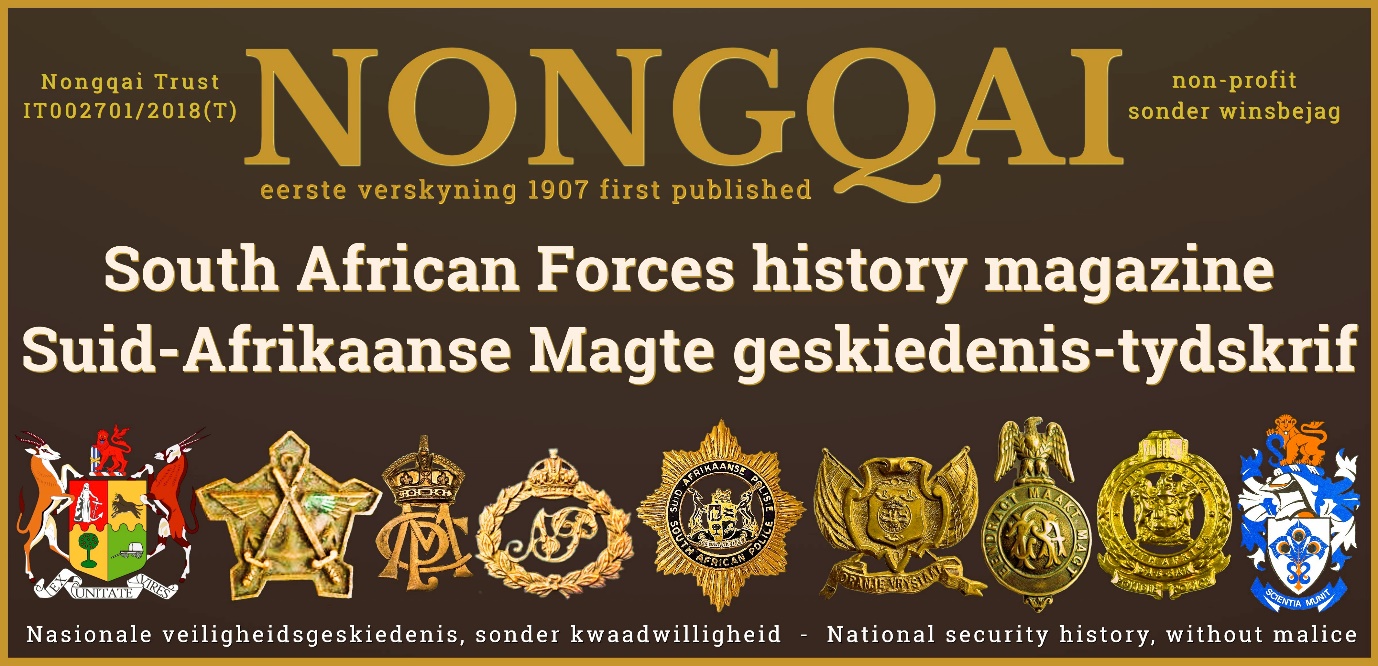NONGQAI: TELL ME ABOUT THE BACKGROUND AND HISTORY OF THE NONGQAI MAGAZINE OF THE SOUTH AFRICAN POLICE
Fanie Avenant & Grok
 Ek het vanmiddag sit en wonder oor die herkoms van Nongqai en gou ‘n Artificial Intelligence navraag aangevra op Grok (Onderafdeling van X) wat ek hierby insluit. Dis wonderlik hoedat AI letterlik vir jou binne ‘n minuut of twee so ‘n dokument kan lewer.
Ek het vanmiddag sit en wonder oor die herkoms van Nongqai en gou ‘n Artificial Intelligence navraag aangevra op Grok (Onderafdeling van X) wat ek hierby insluit. Dis wonderlik hoedat AI letterlik vir jou binne ‘n minuut of twee so ‘n dokument kan lewer.
My oorlede vader was ook ‘n polisieman en ek het met die Nongqai grootgeword. Ek was altyd so trots en selfvoldaan wanneer ek van die ooms op foto’s in die tydskrif kon identifiseer.
Ek was slegs vanaf Januarie 1968 tot Desember 1972 voltyds in die Mag, maar later weer byna tien jaar of langer ‘n reservis en baie nou met die Pretoria Handelstak saamgewerk in veral die bekamping van kredietkaartbedrog.
Beste wense,
Fanie Avenant
Tell me about the background and history of the Nongqai Magazine of the South African Police
The Nongqai magazine is a significant historical publication tied to the South African Police (SAP) and, at times, the South African Prisons Service. Below is a concise overview of its background and history:
Background
Name and Origin: “Nongqai” comes from a Zulu term linked to messengers or enforcers of authority, reflecting its role as a communication tool for the police. Launched in 1907, it was initially the official magazine of the Natal Police, aimed at fostering unity, sharing operational updates, and documenting police activities.
Purpose: The magazine provided non-political, non-critical content, covering police operations, historical accounts, personal stories, sports, and humor. Later, it included prison news and Afrikaans short stories, appealing to both SAP members and the public.
Historical Timeline
1907 – Launch: The first issue (Volume 1, Number 1) was published for the quarter ending March 1907, serving the Natal Police. Priced at 6d, it sold 1,130 copies initially, focusing on policing challenges, district reports, and short story competitions.
1913 – National Scope: After the 1910 Union of South Africa, Nongqai became the SAP’s national magazine on April 1, 1913, absorbing regional publications like The Bandolier and The Transvaal Police Magazine. It adopted bilingual (English and Afrikaans) content.
Early Content: Early issues detailed colonial policing, such as patrols in rebellious areas (e.g., Langalibalele Location, 1874) and support for colonial annexations. By the 1960s, it included international police news and Afrikaans literature.
1943 – Wartime Role: During World War II, Nongqai boosted morale for SAP members, including the South African Police Brigade, with issues like Volume XXXIV, No. 9 (1943) published from SAP Headquarters in Pretoria.
Apartheid and Beyond: Over its 54-year original run (1907–1961), Nongqai reflected SAP’s role in turbulent times, including the Border War and apartheid-era security operations, while maintaining an apolitical stance. Its tone often supported police perspectives.
Name Changes: Post-1961, it evolved into Justitia, SARP, SAP, and finally Servamus (1990s onward). By 2001, Servamus shifted to a broader safety and security focus, moving away from its SAP-exclusive roots.
Modern Revival
Digital Era: Since around 2015, retired SAP Brigadier Hennie Heymans revived Nongqai as a free monthly e-magazine on platforms like ISSUU and www.nongqai.org. It focuses on SAP, South African Defence Force, and Railways Police history, featuring photos, memoirs, and special editions (e.g., 2020 SAP Good Service Medal issue).
Content Scope: Covers historical accounts, specialized units (e.g., Water Police), and security-related topics like the Anglo-Boer War and intelligence operations, preserving South Africa’s security forces’ legacy.
Significance
Longevity: One of South Africa’s oldest magazines, running from 1907 to 1961 and revived digitally, it’s a key historical archive for policing and security studies.
Cultural Role: It fostered SAP camaraderie and now connects veterans and historians. However, its apartheid-era content requires critical analysis due to the SAP’s controversial role.
Access: Historical copies are in archives (e.g., Imperial War Museums) or antiquarian markets. Digital editions are freely available at www.nongqai.org or www.samirror.com.
Key Figure
Hennie Heymans: A Pretoria-based SAP veteran with academic credentials in national security, Heymans drives the modern Nongqai, compiling extensive historical content for researchers and enthusiasts.
For more, explore www.nongqai.org. Critically cross-reference apartheid-era content with diverse sources for a balanced perspective.

